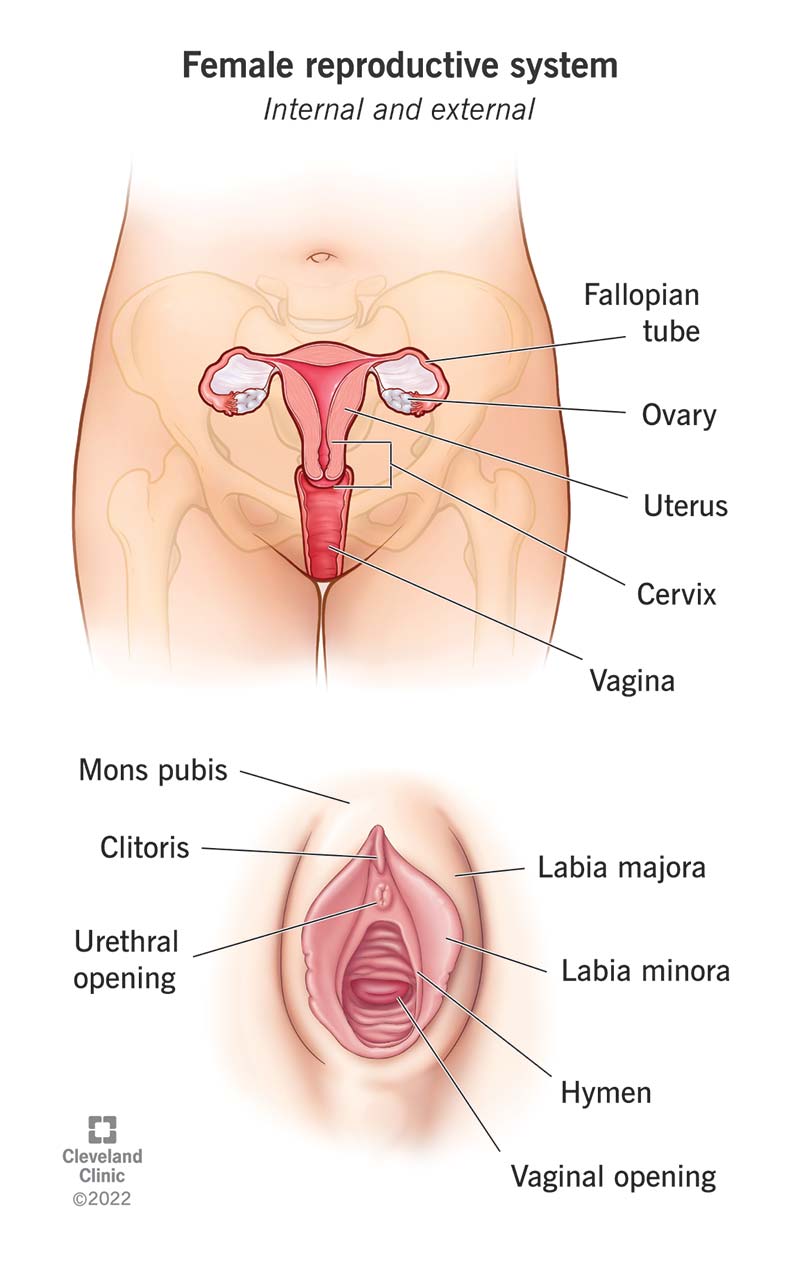The female reproductive system consists of internal and external organs. It creates hormones and is responsible for fertility, menstruation and sexual activity.
Advertisement
Cleveland Clinic is a non-profit academic medical center. Advertising on our site helps support our mission. We do not endorse non-Cleveland Clinic products or services. Policy

The female reproductive system is the body parts that help you:
Advertisement
Cleveland Clinic is a non-profit academic medical center. Advertising on our site helps support our mission. We do not endorse non-Cleveland Clinic products or services. Policy
The female reproductive anatomy includes both external and internal parts.
The function of your external genitals are to protect the internal parts from infection and allow sperm to enter your vagina.
Your vulva is the collective name for all your external genitals. A lot of people mistakenly use the term “vagina” to describe all female reproductive parts. However, your vagina is its own structure located inside your body.
The main parts of your vulva or external genitals are:
Advertisement
The female reproductive system provides several functions. In addition to allowing you to have sexual intercourse, it also helps you reproduce.
Your ovaries produce eggs. These eggs are then transported to your fallopian tube during ovulation where fertilization by a sperm may occur. The fertilized egg then moves to your uterus, where the uterine lining has thickened in response to the normal hormones of your menstrual cycle (also called your reproductive cycle). Once in your uterus, the fertilized egg can implant into the thickened uterine lining and continue to develop. If implantation doesn’t take place, the uterine lining is shed as your menstrual period. In addition, the female reproductive system produces sex hormones that maintain your menstrual cycle.
During menopause, the female reproductive system gradually stops making the female hormones necessary for the menstrual cycle to work. At this point, menstrual cycles can become irregular and eventually stop. You’re considered to be menopausal when you’ve gone an entire year without a menstrual period.
Females of reproductive age (beginning anywhere from 11 to 16 years of age) experience cycles of hormonal activity that repeat at about one-month intervals. With every cycle, your body prepares for a potential pregnancy, whether or not that’s your intention. The term menstruation refers to the periodic shedding of your uterine lining when pregnancy doesn’t occur that cycle. Many call the days that they notice vaginal bleeding their “period.”
Advertisement
The average menstrual cycle takes about 28 days and occurs in phases. These phases include:
There are four major hormones (chemicals that stimulate or regulate the activity of cells or organs) involved in the menstrual cycle. These hormones include:
This phase starts on the first day of your period. During the follicular phase of the menstrual cycle, the following events occur:
Advertisement
The ovulatory phase (ovulation) usually starts about 14 days after the follicular phase began (the exact timing varies). The ovulatory phase is the second phase of your menstrual cycle. Most females will have a menstrual period 10 to 16 days after ovulation. During this phase, the following events occur:
The luteal phase begins right after ovulation and involves the following processes:
Advertisement
You’re born with all the eggs you’ll ever produce. During fetal development, you have about 6 million eggs. At birth, there are approximately 1 million eggs left. By the time you reach puberty, only about 300,000 remain. The number of eggs you have continues to decline as you age and menstruate each cycle. Fertility also declines with age due to the decreasing number and quality of your remaining eggs.
In humans, female and male reproductive systems work together to reproduce. There are two kinds of sex cells — sperm and eggs. When a sperm meets an egg, it can fertilize it and create a zygote. This zygote eventually becomes a fetus. Both a sperm and an egg are needed for human reproduction.
The female reproductive organs are involved in sexual activity, fertility, menstruation and reproduction. Everyone’s reproductive organs look slightly different. Some people are born with missing or irregularly-shaped reproductive organs. This can affect the functions of your reproductive system and lead to irregular bleeding, difficulty conceiving or painful sex. Contact your healthcare provider if you have concerns about your genitals or have symptoms that concern you.
From routine pelvic exams to high-risk pregnancies, Cleveland Clinic’s Ob/Gyns are here for you at any point in life.

Last reviewed on 11/28/2022.
Learn more about the Health Library and our editorial process.